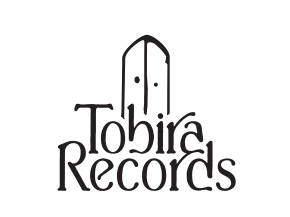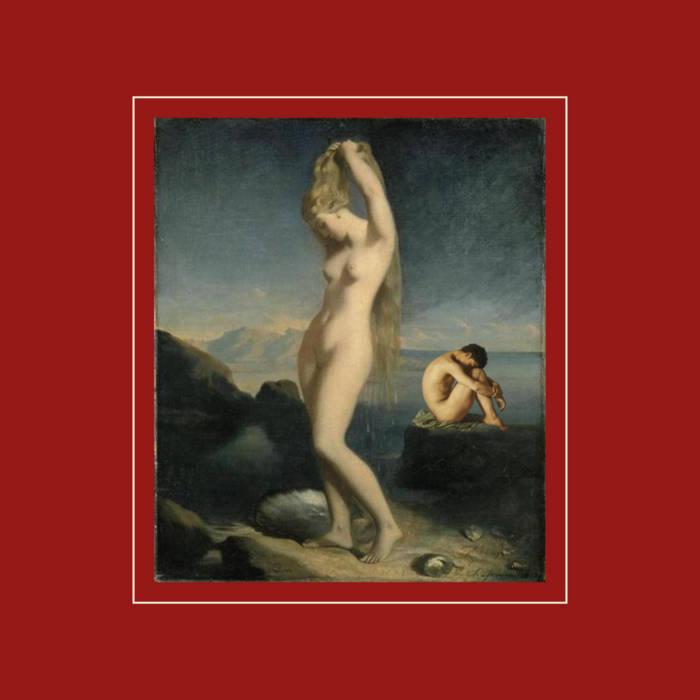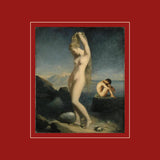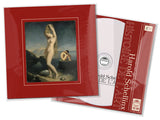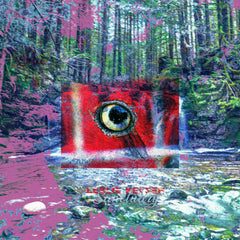Harold Schellinx // Histoire de l’Art CDr
- Availability:
オランダの実験音楽家Harold Schellinxが、2022年7月にギリシャの実験レーベルCoherent Statesから50部限定でリリースしたCDrです。
大学の講義中のタイプ音のみで制作したミニマル物音8曲を収録。廃盤です。
以下、レーベルによる解説です。
2018年の秋、Harold Schellinxの親しい友人が、パリ第1パンテオン・ソルボンヌ大学UFR3校で美術史の学部生として登録しました。フランス語は母国語ではないため、彼女はiPhoneのディクタフォンアプリで、受講している多くのライブ講義を録音し、いずれその一部または全部を聴き直せるようにしました。講義中、ノートPCのキーボードにメモを取る学生も少なくありません。この学生たちがノートを取る音と入力する音は、同時に大合唱となり、講義時間のほとんど全てに渡って持続的かつ多層的な機械の囁きや囁きが続きます。そして、時折、背景から前景にフェードアウトしていきます。それは、講演者が話を中断し、静止しているわずかな時間の間でした。
ハロルド・シェリンクスは、この録音にアクセスし、講師の言葉をすべて削除しました。その結果、美術史の講師が話す言葉をデジタル・テキスト・ファイルに取り込みながら、何台ものラップトップ・キーボードを高速で鳴らし、千匹の電気虫が一斉に鳴き、歌うような、この驚くべき海や雨のような音が残されました。このタイピングの合唱は、さらに、学生の動きや咳、くしゃみなどの環境音も交えて行われます。特に、コロナパンデミックの初期に行われた講義では、閉じこもる直前、つまり大学の授業が物理的な部屋からバーチャルなズームに移る直前のものでした。
Coherent Statesから発売中の「Histoire de l'Art」cdrは、歴史の部分を除いた歴史講義です。講師が言葉を話し、それがフレーズとなり、受講生はそれを聞いて何らかの形で理解します。受講生の頭の中では、その言葉が再び組み合わされ、ほとんどの場合、別のフレーズや言葉に解釈され、その文字を一つずつ、パソコンのキーボードの対応するキーを押すことによってノートパソコンのメモリに転送し、講師の教えを理解したことをデジタルテキストファイルとして保存する、という興味深いアナログ-デジタルデータ転送の過程を記録するオーディオレコードでもあります。このアルバムは、それを聴かせてくれます。
ハロルド・シェリンクスは、アーティストであり、作家であり、即興演奏家であり、珍しい音楽の創造者です。70年代後半にヤングライオンズや他のポストパンクバンドのメンバーとして活躍したほか、「ウルトラ」ムーブメント(国際的に「ポストパンク実験ポップス」として知られるようになったオランダ版)を最初に起こした一人で、オランダの現代音楽誌「Vinyl」の共同設立者、編集者、ロンドン特派員でもあります。ソノロジー研究所で形式音楽とコンピュータ支援作曲を、アムステルダム大学で数学とその基礎を学ぶ。ナイジェル・ジャックリンと彼のエイリアン・ブレインズ・プロジェクトのように、80年代のインダストリアル・ミュージックの重要なパイオニアたちの指導者であり、彼もまた短期間のメンバーでした。ディクタフォンの実験者であり、折衷的なメディアデュオ「okoi」のメンバーであり、オンライン「found tapes exhibition」のキュレーターでもあります。パリを拠点とする電子音響即興カルテットDiktatのメンバーで、2016年にCoherent Statesから「Tour De Force」(CS-7)がリリースされています。
レーベルその他作品はこちら /// Click here to see more Coherent States releases available at Tobira.
------------------------
Edition of 50. Hand-stamped CDR includes 8-page booklet.
Tracklist:
1 Les Mondes de Degas (Degas’ Worlds) |
2 Art et Archéologie de la Gaule Romaine (Art and Archaeology of Roman Gaul)
3 Institutions artistiques (Arts institutions)
4 Méthodologie en histoire sociale de l’art (Methodology in social history of art)
5 Histoire du Patrimoine et des Musées (History of Heritage and Museums)
6 Art du XIXe siècle - Portrait (19th century art – Portrait)
7 Renaissance française à la cour d’Henri II et de Cathérine de Médicis (French Renaissance at the court of Henri II and Cathérine de Médicis)
8 Art du XXe siècle - Surréalisme (20th century art - Surrealism)
++
Coherent States:
"In the fall of 2018 a close friend of Harold Schellinx registered as an undergraduate student in art history at the Université Paris 1 Panthéon Sorbonne UFR3. As French is not her mother tongue, she recorded the many live-lectures she was attending with a dictaphone application on her iPhone, so as to be able to eventually re-listen to, all or parts of, some of them. During these lectures a substantial fraction of the students took notes, typing them on the keyboards of their laptops. The sound of this students’ note-taking-typing simultaneously made for a grand choir, a persistent and multi-layered mechanical whisper- and whimpering that lasted for almost all of a lecture’s duration. And every now and then from background it faded into foreground. That was during the snippets of time in which the lecturer halted her or his speaking, and kept still.
Harold Schellinx was given access to these recordings from which he then removed all of the lecturers’ words. What was left is this amazing ocean/rain-like sound, as of a thousand electric insects, nibbling and singing in unison, brought forth by many, many laptop keyboards' hi-speed rattling, while capturing the words spoken by the art history lecturer in some or other digital text file. And this typing choir moreover comes interspersed with environmental sounds, of students moving, coughing and sneezing, especially in those lectures that took place in the early days of the corona pandemic, shortly before confinement and hence before the university’s classes moved from physical rooms to virtual zooms.
"Histoire de l’Art" cdr, out now on Coherent States, is a history lecture without the history parts. It is also an audio record that documents an interesting analogue-to-digital data-transfer process: the lecturer speaks words; these combine into phrases, that are heard and understood in some form or other by the students; in their heads they re-combine and most of the time also re-interpret these words; into different phrases and words, the letters of which they then one by one transfer to their laptop’s memory by hitting the corresponding keys on their computer keyboard, to save their understanding of the lecturer’s teaching as a digital text file. That is what this album makes you hear. That is "Histoire de l’Art".
Harold Schellinx is an artist, writer, improvisor and creator of unusual music. Apart from being a member of The Young Lions and several other post-punk bands in the late 70's, he was one of the first people who initiated the ‘Ultra’ movement (the dutch version of what internationally became known as ‘post-punk experimental pop music’) and also co-founder, editor and London correspondent of the dutch modern music magazine ‘Vinyl’. Schellinx studied formal music and computer assisted composition at the Institute of Sonology and mathematics and its foundations at the University of Amsterdam. He has been a mentor to many significant pioneers of industrial music of the 80s, like Nigel Jacklin and his Alien Brains project, of which he was also a brief member. A dictaphone experimentator, member of the eclectic media duo ‘ookoi’ and curator of the online ‘found tapes exhibition’. He is a member of the Paris based electroacoustic improvisation quartet Diktat whose "Tour De Force" (CS-7) was released by Coherent States back in 2016. "
++
Information about the cover artwork:
"The cover picture is a mashup that one evening Chen Yungwei made of two classic French paintings, that both date from the 1830’s, a little less than two centuries ago: the ‘Vénus Anadyomène’ (also called ‘Vénus marine’, Venus of the sea) by Théodore Chassériau, presented at the Paris Salon in 1839, and the Study (Young male nude seated beside the Sea, in French: Jeune homme nu assis au bord de la mer, figure d’étude), painted in 1835 by Hippolyte Flandrin while in residency in Rome (the artist had won the Prix de Rome in 1832)."
Artist : Harold Schellinx
Label : Coherent States
オランダの実験音楽家Harold Schellinxが、2022年7月にギリシャの実験レーベルCoherent Statesから50部限定でリリースしたCDrです。
大学の講義中のタイプ音のみで制作したミニマル物音8曲を収録。廃盤です。
以下、レーベルによる解説です。
2018年の秋、Harold Schellinxの親しい友人が、パリ第1パンテオン・ソルボンヌ大学UFR3校で美術史の学部生として登録しました。フランス語は母国語ではないため、彼女はiPhoneのディクタフォンアプリで、受講している多くのライブ講義を録音し、いずれその一部または全部を聴き直せるようにしました。講義中、ノートPCのキーボードにメモを取る学生も少なくありません。この学生たちがノートを取る音と入力する音は、同時に大合唱となり、講義時間のほとんど全てに渡って持続的かつ多層的な機械の囁きや囁きが続きます。そして、時折、背景から前景にフェードアウトしていきます。それは、講演者が話を中断し、静止しているわずかな時間の間でした。
ハロルド・シェリンクスは、この録音にアクセスし、講師の言葉をすべて削除しました。その結果、美術史の講師が話す言葉をデジタル・テキスト・ファイルに取り込みながら、何台ものラップトップ・キーボードを高速で鳴らし、千匹の電気虫が一斉に鳴き、歌うような、この驚くべき海や雨のような音が残されました。このタイピングの合唱は、さらに、学生の動きや咳、くしゃみなどの環境音も交えて行われます。特に、コロナパンデミックの初期に行われた講義では、閉じこもる直前、つまり大学の授業が物理的な部屋からバーチャルなズームに移る直前のものでした。
Coherent Statesから発売中の「Histoire de l'Art」cdrは、歴史の部分を除いた歴史講義です。講師が言葉を話し、それがフレーズとなり、受講生はそれを聞いて何らかの形で理解します。受講生の頭の中では、その言葉が再び組み合わされ、ほとんどの場合、別のフレーズや言葉に解釈され、その文字を一つずつ、パソコンのキーボードの対応するキーを押すことによってノートパソコンのメモリに転送し、講師の教えを理解したことをデジタルテキストファイルとして保存する、という興味深いアナログ-デジタルデータ転送の過程を記録するオーディオレコードでもあります。このアルバムは、それを聴かせてくれます。
ハロルド・シェリンクスは、アーティストであり、作家であり、即興演奏家であり、珍しい音楽の創造者です。70年代後半にヤングライオンズや他のポストパンクバンドのメンバーとして活躍したほか、「ウルトラ」ムーブメント(国際的に「ポストパンク実験ポップス」として知られるようになったオランダ版)を最初に起こした一人で、オランダの現代音楽誌「Vinyl」の共同設立者、編集者、ロンドン特派員でもあります。ソノロジー研究所で形式音楽とコンピュータ支援作曲を、アムステルダム大学で数学とその基礎を学ぶ。ナイジェル・ジャックリンと彼のエイリアン・ブレインズ・プロジェクトのように、80年代のインダストリアル・ミュージックの重要なパイオニアたちの指導者であり、彼もまた短期間のメンバーでした。ディクタフォンの実験者であり、折衷的なメディアデュオ「okoi」のメンバーであり、オンライン「found tapes exhibition」のキュレーターでもあります。パリを拠点とする電子音響即興カルテットDiktatのメンバーで、2016年にCoherent Statesから「Tour De Force」(CS-7)がリリースされています。
レーベルその他作品はこちら /// Click here to see more Coherent States releases available at Tobira.
------------------------
Edition of 50. Hand-stamped CDR includes 8-page booklet.
Tracklist:
1 Les Mondes de Degas (Degas’ Worlds) |
2 Art et Archéologie de la Gaule Romaine (Art and Archaeology of Roman Gaul)
3 Institutions artistiques (Arts institutions)
4 Méthodologie en histoire sociale de l’art (Methodology in social history of art)
5 Histoire du Patrimoine et des Musées (History of Heritage and Museums)
6 Art du XIXe siècle - Portrait (19th century art – Portrait)
7 Renaissance française à la cour d’Henri II et de Cathérine de Médicis (French Renaissance at the court of Henri II and Cathérine de Médicis)
8 Art du XXe siècle - Surréalisme (20th century art - Surrealism)
++
Coherent States:
"In the fall of 2018 a close friend of Harold Schellinx registered as an undergraduate student in art history at the Université Paris 1 Panthéon Sorbonne UFR3. As French is not her mother tongue, she recorded the many live-lectures she was attending with a dictaphone application on her iPhone, so as to be able to eventually re-listen to, all or parts of, some of them. During these lectures a substantial fraction of the students took notes, typing them on the keyboards of their laptops. The sound of this students’ note-taking-typing simultaneously made for a grand choir, a persistent and multi-layered mechanical whisper- and whimpering that lasted for almost all of a lecture’s duration. And every now and then from background it faded into foreground. That was during the snippets of time in which the lecturer halted her or his speaking, and kept still.
Harold Schellinx was given access to these recordings from which he then removed all of the lecturers’ words. What was left is this amazing ocean/rain-like sound, as of a thousand electric insects, nibbling and singing in unison, brought forth by many, many laptop keyboards' hi-speed rattling, while capturing the words spoken by the art history lecturer in some or other digital text file. And this typing choir moreover comes interspersed with environmental sounds, of students moving, coughing and sneezing, especially in those lectures that took place in the early days of the corona pandemic, shortly before confinement and hence before the university’s classes moved from physical rooms to virtual zooms.
"Histoire de l’Art" cdr, out now on Coherent States, is a history lecture without the history parts. It is also an audio record that documents an interesting analogue-to-digital data-transfer process: the lecturer speaks words; these combine into phrases, that are heard and understood in some form or other by the students; in their heads they re-combine and most of the time also re-interpret these words; into different phrases and words, the letters of which they then one by one transfer to their laptop’s memory by hitting the corresponding keys on their computer keyboard, to save their understanding of the lecturer’s teaching as a digital text file. That is what this album makes you hear. That is "Histoire de l’Art".
Harold Schellinx is an artist, writer, improvisor and creator of unusual music. Apart from being a member of The Young Lions and several other post-punk bands in the late 70's, he was one of the first people who initiated the ‘Ultra’ movement (the dutch version of what internationally became known as ‘post-punk experimental pop music’) and also co-founder, editor and London correspondent of the dutch modern music magazine ‘Vinyl’. Schellinx studied formal music and computer assisted composition at the Institute of Sonology and mathematics and its foundations at the University of Amsterdam. He has been a mentor to many significant pioneers of industrial music of the 80s, like Nigel Jacklin and his Alien Brains project, of which he was also a brief member. A dictaphone experimentator, member of the eclectic media duo ‘ookoi’ and curator of the online ‘found tapes exhibition’. He is a member of the Paris based electroacoustic improvisation quartet Diktat whose "Tour De Force" (CS-7) was released by Coherent States back in 2016. "
++
Information about the cover artwork:
"The cover picture is a mashup that one evening Chen Yungwei made of two classic French paintings, that both date from the 1830’s, a little less than two centuries ago: the ‘Vénus Anadyomène’ (also called ‘Vénus marine’, Venus of the sea) by Théodore Chassériau, presented at the Paris Salon in 1839, and the Study (Young male nude seated beside the Sea, in French: Jeune homme nu assis au bord de la mer, figure d’étude), painted in 1835 by Hippolyte Flandrin while in residency in Rome (the artist had won the Prix de Rome in 1832)."
Artist : Harold Schellinx
Label : Coherent States
